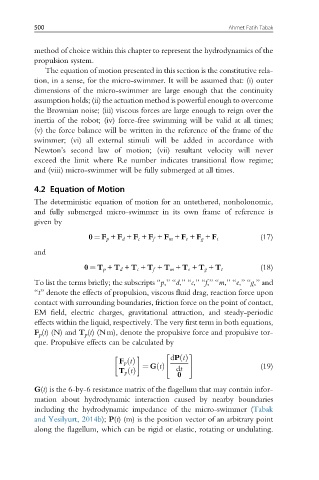Page 506 - Handbook of Biomechatronics
P. 506
500 Ahmet Fatih Tabak
method of choice within this chapter to represent the hydrodynamics of the
propulsion system.
The equation of motion presented in this section is the constitutive rela-
tion, in a sense, for the micro-swimmer. It will be assumed that: (i) outer
dimensions of the micro-swimmer are large enough that the continuity
assumption holds; (ii) the actuation method is powerful enough to overcome
the Brownian noise; (iii) viscous forces are large enough to reign over the
inertia of the robot; (iv) force-free swimming will be valid at all times;
(v) the force balance will be written in the reference of the frame of the
swimmer; (vi) all external stimuli will be added in accordance with
Newton’s second law of motion; (vii) resultant velocity will never
exceed the limit where Re number indicates transitional flow regime;
and (viii) micro-swimmer will be fully submerged at all times.
4.2 Equation of Motion
The deterministic equation of motion for an untethered, nonholonomic,
and fully submerged micro-swimmer in its own frame of reference is
given by
(17)
0 ¼ F p + F d + F c + F f + F m + F e + F g + F t
and
(18)
0 ¼ T p + T d + T c + T f + T m + T e + T g + T t
To list the terms briefly; the subscripts “p,” “d,” “c,” “f,” “m,” “e,” “g,” and
“t” denote the effects of propulsion, viscous fluid drag, reaction force upon
contact with surrounding boundaries, friction force on the point of contact,
EM field, electric charges, gravitational attraction, and steady-periodic
effects within the liquid, respectively. The very first term in both equations,
F p (t) (N) and T p (t) (Nm), denote the propulsive force and propulsive tor-
que. Propulsive effects can be calculated by
" #
dP tðÞ
F p tðÞ
¼ G tðÞ (19)
T p tðÞ dt
0
G(t) is the 6-by-6 resistance matrix of the flagellum that may contain infor-
mation about hydrodynamic interaction caused by nearby boundaries
including the hydrodynamic impedance of the micro-swimmer (Tabak
and Yesilyurt, 2014b); P(t) (m) is the position vector of an arbitrary point
along the flagellum, which can be rigid or elastic, rotating or undulating.

